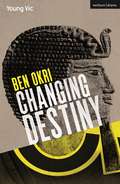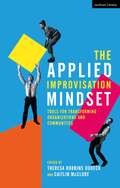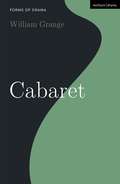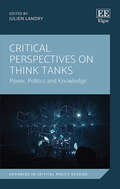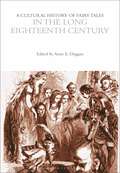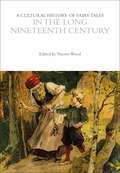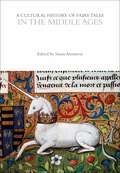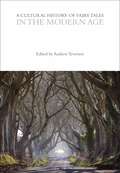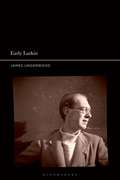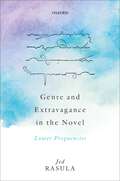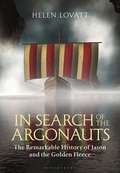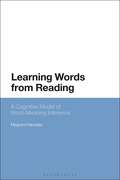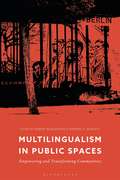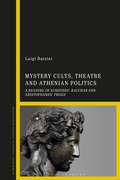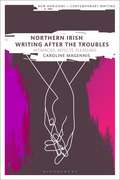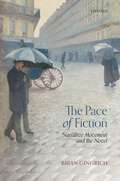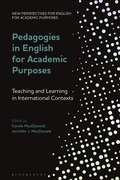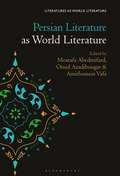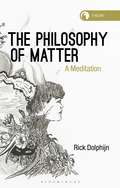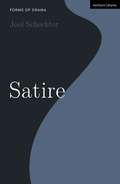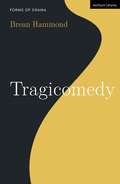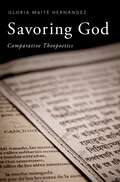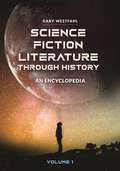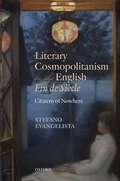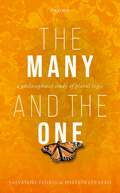- Table View
- List View
Changing Destiny (Modern Plays)
by Ben OkriTwo actors, a thousand characters, and the story of how a kingdom is changed… An epic new adaptation of the 4,000-year-old Egyptian poem about the Warrior King, Sinuhe written by Booker Prize-winner Ben Okri that captures the essence of humanity and the complexities of immigration. This edition of Changing Destiny is published to coincide with the world premiere performance at London's Young Vic Theatre, directed by Young Vic Artistic Director Kwame Kwei-Armah.
The Applied Improvisation Mindset: Tools for Transforming Organizations and Communities
How can the practice of improvisation become the lens through which we view the world? The Applied Improvisation Mindset takes readers deep into the maturing field of Applied Improvisation (AI), with stories of 18 practitioners from five countries who embrace an improvisation mindset to create a more collaborative, equitable, sustainable, and joyous world. Myriad organizations have discovered how the mindset and skills applied by great improvisers onstage can reveal emergent, generative ways of interacting with others offstage.With case studies on developing presentation skills, reducing anxiety in teens, or preparing climate risk managers across the globe for the challenges ahead, this second volume serves as a valuable resource for both experienced and new AI facilitators. It is a primer for higher education and K-12 faculty combatting traditional teaching limitations and a practical “how to” for theatre practitioners, artists, educators, or anyone seeking to transform their organizations and communities.
Cabaret (Forms of Drama)
by William GrangeWhere did cabaret come from? What has it got to do with pre-war Berlin, decadent society and Nazis? How does it turn into media cabaret and the sisterhood of sleaze? Is cabaret a primary vehicle for exploring the range of sexual practices and alternative sexual identities?In this new book William Grange brings into one place for the first time the range of practices now associated with the form of cabaret. Beginning with its origins in speciality German theatres and the development both of the sheet music industry and disc recordings, Grange tracks the form through into its golden age in the 1920s and beyond.The book's three sections deal first with the emergence of Berlin as the 'German Chicago', where cabaret flourished in the midst of post-war political turmoil. The abolition of censorship allowed nude dancing and sexually explicit songs and routines. It also saw the introduction of kick-line dancing and black performers. In the book's second and third sections Grange takes the story forward into the post second-world-war world, describing how the form moved outwards from central Europe to move across the whole world, reaching Singapore and Australia, and as it did so settling into the range of forms in which we know it today. Some of these forms became 'media cabaret' looking towards the new media age, the postmodernism that followed on from modernism. To this age, even in its new forms, cabaret brought its old habits of making challenges to assumptions around gender identities and sexual practices. As throughout its whole history, cabaret was a form that provided particular vehicles for female performers. And whereas it once served up whore songs and nude dancing it now offers a sisterhood of sleaze.
Critical Perspectives on Think Tanks: Power, Politics and Knowledge (Advances in Critical Policy Studies series)
This innovative book explores think tanks from the perspective of critical policy studies, showcasing how knowledge, power and politics intersect with the ways in which think tanks intervene in public policy.Expert contributors offer multidisciplinary analyses of the history of policy advice and expertise and highlight recent examples of how think tanks navigate public debates, political arenas and the backstage of decision-making. They provide an overview of historical developments in the emergence and evolution of think tanks and consider how current think tanks produce policy narratives and exercise influence through the power of ideas. Focusing on institutional structures and social forces, chapters explain how national and transnational think tank landscapes are organized and how think tanks shape knowledge production infrastructure in different governance contexts. The book concludes that evaluating this infrastructure is crucial for ensuring that policy discourse serves collective interests and inclusive policy learning in diverse democratic polities.This book's evaluation of the impact of think tanks on expertise, democracy and social justice, while utilizing rigorous empirical research, will be useful for scholars and students of public policy, political theory and public administration and management. It will also be beneficial for think tankers and policy analysts.
A Cultural History of Fairy Tales in the Long Eighteenth Century (The Cultural Histories Series)
How have fairy tales from around the world changed over the centuries? What do they tell us about different cultures and societies?This volume traces the evolution of the genre over the period known as the long eighteenth century. It explores key developments including: the French fairy tale vogue of the 1690s, dominated by women authors including Marie-Catherine d'Aulnoy and Marie-Jeanne Lhéritier, the fashion of the oriental tale in the early eighteenth century, launched by Antoine Galland's seminal translation of The Thousand and One Nights from Arabic into French, and the birth of European children's literature in the second half of the eighteenth century. Drawing together contributions from an international range of scholars in history, literature and cultural studies, this volume examines the intersections between diverse national tale traditions through different critical perspectives, producing an authoritative transnational history of the genre. An essential resource for researchers, scholars and students of literature, history and cultural studies, this book explores such themes and topics as: forms of the marvelous, adaptation, gender and sexuality, humans and non-humans, monsters and the monstrous, spaces, socialization, and power.A Cultural History of Fairy Tales (6-volume set)A Cultural History of Fairy Tales in Antiquity is also available as a part of a 6-volume set, A Cultural History of Fairy Tales, tracing fairy tales from antiquity to the present day, available in print, or within a fully-searchable digital library accessible through institutions by annual subscription or on perpetual access (see www.bloomsburyculturalhistory.com). Individual volumes for academics and researchers interested in specific historical periods are also available digitally via www.bloomsburycollections.com.
A Cultural History of Fairy Tales in the Long Nineteenth Century (The Cultural Histories Series)
How have fairy tales from around the world changed over the centuries? What do they tell us about different cultures and societies?This volume explores the period when the European fairy tales conquered the world and shaped the global imagination in its own image. Examining how collectors, children's writers, poets, and artists seized the form to challenge convention and normative ideas, this book explores the fantastic imagination that belies the nineteenth century's materialist and pedestrian reputation. Looking at writers including E.T.A Hoffman, the Brothers Grim, S.T. Coleridge, Walter Scott, Oscar Wilde, Christina Rosetti, George MacDonald, and E. Nesbit, the volume shows how fairy tales touched every aspect of nineteenth century life and thought. It provides new insights into themes including: forms of the marvelous, adaptation, gender and sexuality, humans and non-humans, monsters and the monstrous, spaces, socialization, and power. With contributions from international scholars across disciplines, this volume is an essential resource for researchers, scholars and students of literature, history, and cultural studies.A Cultural History of Fairy Tales (6-volume set)A Cultural History of Fairy Tales in Antiquity is also available as a part of a 6-volume set, A Cultural History of Fairy Tales, tracing fairy tales from antiquity to the present day, available in print, or within a fully-searchable digital library accessible through institutions by annual subscription or on perpetual access (see www.bloomsburyculturalhistory.com). Individual volumes for academics and researchers interested in specific historical periods are also available digitally via www.bloomsburycollections.com.
A Cultural History of Fairy Tales in the Middle Ages (The Cultural Histories Series)
How have fairy tales from around the world changed over the centuries? What do they tell us about different cultures and societies? Spanning the years from 900 to 1500 and traversing geographical borders, from England to France and India to China, this book uniquely examines the tales told, translated, adapted and circulated during the period known as the Middle Ages. Scholars in history, literature and cultural studies explore the development of epic tales of heroes and monsters and enchanted romance narratives. Examining how tales evolved and functioned across different societies during the Middle Ages, this book demonstrates how the plots, themes and motifs used in medieval tales influenced later developments in the genre. An essential resource for researchers, scholars and students of literature, history and cultural studies, this volume explores themes including: forms of the marvelous, adaptation, gender and sexuality, humans and non-humans, monsters and the monstrous, spaces, socialization, and power.A Cultural History of Fairy Tales (6-volume set)A Cultural History of Fairy Tales in Antiquity is also available as a part of a 6-volume set, A Cultural History of Fairy Tales, tracing fairy tales from antiquity to the present day, available in print, or within a fully-searchable digital library accessible through institutions by annual subscription or on perpetual access (see www.bloomsburyculturalhistory.com). Individual volumes for academics and researchers interested in specific historical periods are also available digitally via www.bloomsburycollections.com.
A Cultural History of Fairy Tales in the Modern Age (The Cultural Histories Series)
How have fairy tales from around the world changed over the centuries? What do they tell us about different cultures and societies?Drawing together contributions from an international range of scholars in history, literature, and cultural studies, this volume uniquely examines creative applications of fairy tales in the twentieth and twenty-first centuries. It explores how the fairy tale has become a genre that flourishes on film, on TV, and in digital media, as well as in the older technologies of print, performance, and the visual arts. An essential resource for researchers, scholars and students of literature, history, the visual arts and cultural studies, this book explores such themes and topics as: forms of the marvelous, adaptation, gender and sexuality, humans and non-humans, monsters and the monstrous, spaces, socialization, and power.A Cultural History of Fairy Tales (6-volume set)A Cultural History of Fairy Tales in Antiquity is also available as a part of a 6-volume set, A Cultural History of Fairy Tales, tracing fairy tales from antiquity to the present day, available in print, or within a fully-searchable digital library accessible through institutions by annual subscription or on perpetual access (see www.bloomsburyculturalhistory.com). Individual volumes for academics and researchers interested in specific historical periods are also available digitally via www.bloomsburycollections.com.
Early Larkin
by James UnderwoodBeginning with Philip Larkin's earliest literary efforts and his remarkable correspondence with Jim Sutton, this book traces the writer's development from the 1930s through to The Less Deceived, his first poetic masterpiece. Drawing on the poetry, novels, short fictions, essays and letters, Underwood presents a new and surprising narrative of Larkin's literary development. Whilst many critics have described Larkin's early career as a false start, overcome by swapping Yeats's example for Hardy's, Underwood emphasises the influence of Brunette Coleman, the female heteronym Larkin invented in 1943. Based on extensive archival research, and covering the full range of Larkin's published and unpublished early writings, this book radically re-thinks Larkin's literary breakthrough. It shows it to be the result of Larkin's burgeoning interest in everything outside himself – itself the consequence of his curious Brunette Coleman experiment.
Genre and Extravagance in the Novel: Lower Frequencies
by Jed RasulaThis book addresses an anomaly in the novel as genre: the generic promise to readers—that "reading a novel" is a familiar and repeatable experience—is challenged by the extravagant exceptions to this rule. Furthermore, these exceptions (such as Moby-Dick, Ulysses, or To the Lighthouse) are sui generis, hybrid concoctions that cannot be said to be typical novels. The novel, then, as literary form, succeeds by extravagantly disregarding or even disavowing the protocols of its own genre. Examining a number of famous examples from Don Quixote to Nostromo, this book offers an anatomy of exceptions that illustrate the structural role of their exceptionality for the prestige of the novel as literary form.
In Search of the Argonauts: The Remarkable History of Jason and the Golden Fleece
by Helen LovattFew classical stories are as exciting as that of Jason and the Golden Fleece. The legend of the boy, who discovers a new identity as son of a usurped king and leads a crew of demi-gods and famous heroes, has resonated through the ages, rumbling like the clashing rocks, which almost pulverised the Argo. The myth and its reception inspires endless engagements: while it tells of a quest to the ends of the earth, of the tyrants Pelias and Aetes, of dragons' teeth, of the loss of Hylas (beloved of Hercules) stolen away by nymphs, and of Jason's seduction of the powerful witch Medea (later betrayed for a more useful princess), it speaks to us of more: of gender and sexuality; of heroism and lost integrity; of powerful gods and terrifying monsters; of identity and otherness; of exploration and exploitation. The Argonauts are emblems of collective heroism, yet also of the emptiness of glory. From Pindar to J. W. Waterhouse, Apollonius of Rhodes to Ray Harryhausen, and Robert Graves to Mary Zimmerman, the Argonaut myth has produced later interpretations as rich, salty and complex as the ancient versions. Helen Lovatt here unravels, like untangled sea-kelp, the diverse strands of the narrative and its numerous and fascinating afterlives. Her book will prove both informative and endlessly entertaining to those who love classical literature and myth.
Learning Words from Reading: A Cognitive Model of Word-Meaning Inference
by Megumi HamadaAn increasingly popular approach to second and foreign language education, this book focuses on incidental learning: how students learn words from reading. Despite its popularity, some researchers have questioned this theory that students can learn new words by inferring meanings based on a text they are reading. So, why does the incidental method not work for some students? What are the conditions for naturalistic learning to occur? What do students need to be able to do while reading in order to learn words successfully?Tackling these questions head-on, this book provides researchers and educators with a more specific account of the processes behind the seemingly naturalistic method. Clarifying the connection between reading and word learning processes, Megumi Hamada proposes a new model, the Cognitive Model of Word-Meaning Inference, to describe how we obtain and use word-form and contextual information for learning words and the pedagogical applications of this. A significant new contribution to research in the field, Learning Words from Reading provides a cognitive perspective on how students learn new words from reading in a second or foreign language.
Multilingualism in Public Spaces: Empowering and Transforming Communities
Advocates of multilingualism are always seeking new ways to articulate the advantages inherent in living out life in more than one language. This volume brings together researchers from across Europe to explore sociolinguistic perspectives on multilingualism, with specific emphasis on identity, diversity, and social cohesion, as they focus explicitly on the potential of this phenomenon to empower individuals, groups, and communities.Positioned around the idea of empowerment, this book explores the potential of multilingualism to overcome divisions and build social cohesion. In particular, chapters discuss how multilingualism can help the individual to become critically conscious and to develop an in-depth understanding of the world, while also benefiting society as whole. Understanding 'public space' in broad terms, including domains such as education, online, and the linguistic landscape, this volume explores how multilingualism can empower people from a range of perspectives, including memorialisation, onomastics, direct action, linguistic rights, migration, and educational play.
Mystery Cults, Theatre and Athenian Politics: A Reading of Euripides' Bacchae and Aristophanes' Frogs
by Luigi BarziniThis new comparative reading of Euripides' Bacchae and Aristophanes' Frogs sets the two plays squarely in their contemporary social and political context and explores their impact on the audiences of the time. Both were composed during a crucial period of Athenian political life following the oligarchic seizure of power in 411 BC and the restoration of democracy in 410 BC, and were in all likelihood produced nearly simultaneously a few months before the rise of the Thirty Tyrants and the ensuing civil war. They also demonstrate significant similarities that are particularly notable among extant Attic theatre productions, including the role of the god Dionysos as protagonist and architect of religious and political action, and the presence of Demetrian and Dionysiac mystic choruses as proponents of the appeasement of civil discord as the cure for Athens' ills. Focusing on the mystic, civic and political content of both Bacchae and Frogs, this volume offers not only a new reading of the plays, but also an interdisciplinary perspective on the special characteristics of mystery cults in Athens in their political context and the nature of theatrical audiences and their reaction to mystic themes. Its illumination of the function of each play at a pivotal moment in fifth-century Athenian politics will be of value to scholars and students of ancient Greek drama, religion and history.
Northern Irish Writing After the Troubles: Intimacies, Affects, Pleasures (New Horizons in Contemporary Writing)
by Caroline MagennisThe period since the Good Friday Agreement in 1998 has seen a sustained decrease in violence and, at the same time, Northern Ireland has undergone a literary renaissance, with a fresh generation of writers exploring innovative literary forms.This book explores contemporary Northern Irish fiction and how the 'post'-conflict period has led writers to a renewed engagement with intimacy and intimate life. Magennis draws on affect and feminist theory to examine depictions of intimacy, pleasure and the body in their writings and shows how intimate life in Northern Ireland is being reshaped and re-written.Featuring short reflective pieces from some of today's most compelling Northern Irish Writers, including Lucy Caldwell, Jan Carson, Bernie McGill and David Park, this book provides authoritative insights into how a contemporary engagement with intimacy provides us with new ways to understand Northern Irish identity, selfhood and community.
The Pace of Fiction: Narrative Movement and the Novel
by Brian GingrichThe Pace of Fiction redefines the literary history of the novel by analyzing its most elaborate feature: its pace. It moves from the rise of the novel to realism and modernism. It starts by tracing the evolution of two narrative units: scenes ("shown" slowly) and summaries ("told" swiftly). These units emerge from the conflict of epic and drama, gain shape in the commentaries of Fielding and Goethe, and become dynamically opposed in nineteenth-century realism. In Middlemarch, they rotate in regular sequence: summaries move swiftly until scenes slow them down; scenes play out dramatically until summaries sweep them forward; their movement imitates the conflict of fate and free will. Over the course of the nineteenth century, however, scenic impulses overtake summary storytelling. The reader sees the tendency already in Austen's dialogues, Hawthorne's tableaux, or Balzac's battering drama, and finds it in Jane Eyre's placement of summaries in private scenes. When Flaubert extends scenic vividness to all of his summaries, and when Henry James subordinates his summaries to scenic consciousness, the extreme pressure of scene upon summary brings the opposition of realist pacing to collapse. But other oppositions arise in the modernisms that follow. In the alternation of stasis and kinesis, of drifting thoughts and everyday actions, of stories and acts of storytelling—in Proust, Joyce, Woolf, Mann, Hemingway—pace gathers and creates meaning in new ways.
Pedagogies in English for Academic Purposes: Teaching and Learning in International Contexts (New Perspectives for English for Academic Purposes)
As the delivery of English for Academic Purposes (EAP) continues to expand internationally, so too must the literature available to support teaching. This volume showcases some of the research-informed work in this exciting and complex field, providing insights into EAP pedagogies employed in a diverse range of contexts. Drawing on the work of practitioners and practitioner-researchers, it responds to the repeated calls for a firmer link between theory, research and practice in language teaching, and provides a much-needed focus on pedagogy. From contexts where English is the principal dominant societal language or one of several official languages, to those where English-medium instruction (EMI) is common in higher education as an additional language for students and faculty, the chapters explore a range of geographical contexts, including Brazil, Canada, China, Norway, South Africa, Turkey, the UAE, the UK and the USA. Diversity is also represented in the range of types of EAP provision featured in this volume. Contributions focus on EAP for undergraduate and postgraduate students, from lower to advanced proficiency levels, before and during degree study, and in English for both general and specific academic purposes teaching, with discussion of consequences for on-going teacher education. Pedagogic responses and innovations to these varied contexts and needs are illustrated in the range of contributions, which provide insights into current practices in EAP globally.
Persian Literature as World Literature (Literatures as World Literature)
Confronting nationalistic and nativist interpreting practices in Persianate literary scholarship, Persian Literature as World Literature makes a case for reading these literatures as world literature-as transnational, worldly texts that expand beyond local and national penchants. Working through an idea of world literature that is both cosmopolitan and critical of any monologic view on globalization, the contributors to this volume revisit the early and contemporary circulation of Persianate literatures across neighboring and distant cultures, and seek innovative ways of developing a transnational Persian literary studies, engaging in constructive dialogues with the global forces surrounding, and shaping, Persianate societies and cultures.
The Philosophy of Matter: A Meditation (Theory in the New Humanities)
by Rick DolphijnThe Philosophy of Matter is a journey in thinking through the material fate of the earth itself; its surfaces and undercurrrents, ecologies, environments and irreparable cracks. With figures such as Spinoza, Gilles Deleuze and Michel Serres as philosophical guides and writings on New Materialism, Posthumanism and Affect Theory as intellectual context, Rick Dolphijn proposes a radical rethinking of some of the basic themes of philosophy: subjectivity, materiality, body (both human and otherwise) and the act of living. This rethink is a work of imagination and meditation in order to conceive of “another earth for another people”. It is a homage to courageous thinking that dares to question the religious, capitalist and humanist realities of the day.A poetic philosophy of how to live in troubling times when even the earth beneath us feels unstable, Dolphijn offers a way to think about the world with depth, honesty and glimpses of hope.
Satire (Forms of Drama)
by Joel SchechterSatire reconsiders the entertainment, political dissent and comic social commentary created by innovative writers and directors since this theatrical form took the stage in ancient Athens. From Aristophanes to the 18th-century plays of John Gay and Henry Fielding, to the creations of Joan Littlewood, Bertolt Brecht, Vsevolod Meyerhold, Erika Mann, Brendan Behan and Dario Fo, practitioners of theatrical satire have prompted audiences to laugh at corruption, greed, injustice and abusive authority.In the theatre these artists jested at prominent citizens, scandals and fashions. In retrospect it can be seen that their topical references, allegories and impersonations also promoted intervention in public discourse and events outside the theatre, as satire extended its reach beyond the stage into society.Satire focuses on three exemplary satiric plays: The Knights by Aristophanes, The Beggar's Opera by John Gay and The Hostage by Brendan Behan under Joan Littlewood's direction. Detailed discussion of these three innovative works reveals both changes and continuities in stage satire over the course of its long, hilarious history. The survey concludes with a discussion of stage satire as an endangered art in need of preservation by actors, directors and theatre historians.
Tragicomedy (Forms of Drama)
by Brean HammondThis succinct authoritative book offers readers an overview of the origins, characteristics, and changing status of tragicomedy from the 17th century to the present. It explores the work of some of the key English and Irish playwrights associated with the form, the influence of Italian and Spanish theorist-playwrights and the importance of translations of Pierre Corneille's Le Cid. At the turn of the 17th century, English dramatists such as John Marston, John Fletcher, and William Shakespeare began experimenting with plays that mixed elements of tragedy and comedy, producing a blended mode that they themselves called 'tragicomedy'. This book begins by examining the sources of their inspiration and the theatrical achievement that they hoped to gain by confronting an audience with plays that defied the plot and character expectations of 'pure' comedy and tragedy. It goes on to show how, reacting to French models, John Dryden, Shakespeare 'improvers' and other English playwrights developed the form while sowing the seeds of its own vulnerability to parody and obsolescence in the eighteenth century. Discussing nineteenth-century melodrama as in some respects a resurrection of tragicomedy, the final chapter concentrates on plays by Ibsen, Chekhov, and Beckett as examples of the form being revived to create theatrical modes that more adequately represent the perceived complexity of experience.
Savoring God: Comparative Theopoetics
by Gloria Maité HernándezSavoring God is a comparative study that examines the creative interaction of poetry and theology in two mystical poems central to the Christian and the Hindu traditions, the sixteenth-century Spanish Cántico espiritual (Spiritual Canticle), by Saint John of the Cross, and the Sanskrit R=asa L=il=a (Dance of Love), which originated in the oral tradition. Alongside the poems, Gloria Maité Hernández examines theological commentaries on the texts: the Comentarios, written by Saint John of the Cross on his own poem, and the foundational commentary on the R=asa L=il=a by 'Sr=idhara Sv=ami as well as commentaries by the sixteenth-century theologian J=iva Gosv=ami, from the Gau.d=iya Vai.s.nava school, and other Gau.d=iya theologians. The phrase "savoring God" conveys the Spanish gustar a Dios (to savor God) and the Sanskrit madhura bhakti rasa (the sweet savor of divine love). In the Christian and Hindu commentaries these two concepts describe a way of approaching the poems that is simultaneously vulnerable to the emotions evoked by the poetical imagery and responsive to its theological demands. While "savoring" does not mean the precisely the same thing to the Christian and the Hindu theologians, Hernández demonstrates that both traditions interpret the term to suggest poetry's power in mediating an encounter with the divine.
Science Fiction Literature through History [2 volumes]: An Encyclopedia [2 volumes]
by Gary WestfahlThis book provides students and other interested readers with a comprehensive survey of science fiction history and numerous essays addressing major science fiction topics, authors, works, and subgenres written by a distinguished scholar.This encyclopedia deals with written science fiction in all of its forms, not only novels and short stories but also mediums often ignored in other reference books, such as plays, poems, comic books, and graphic novels. Some science fiction films, television programs, and video games are also mentioned, particularly when they are relevant to written texts. Its focus is on science fiction in the English language, though due attention is given to international authors whose works have been frequently translated into English.Since science fiction became a recognized genre and greatly expanded in the 20th century, works published in the 20th and 21st centuries are most frequently discussed, though important earlier works are not neglected. The texts are designed to be helpful to numerous readers, ranging from students first encountering science fiction to experienced scholars in the field.
Literary Cosmopolitanism in the English Fin de Siècle: Citizens of Nowhere
by Stefano EvangelistaThe fin de siècle witnessed an extensive and heated debate about cosmopolitanism, which transformed readers' attitudes towards national identity, foreign literatures, translation, and the idea of world literature. Focussing on literature written in English, Literary Cosmopolitanism in the English Fin de Siècle offers a critical examination of cosmopolitanism as a distinctive feature of the literary modernity of this important period of transition. No longer conceived purely as an abstract philosophical ideal, cosmopolitanism—or world citizenship—informed the actual, living practices of authors and readers who sought new ways of relating local and global identities in an increasingly interconnected world. The book presents literary cosmopolitanism as a field of debate and controversy. While some writers and readers embraced the creative, imaginative, emotional, and political potentials of world citizenship, hostile critics denounced it as a politically and morally suspect ideal, and stressed instead the responsibilities of literature towards the nation. In this age of empire and rising nationalism, world citizenship came to enshrine a paradox: it simultaneously connoted positions of privilege and marginality, connectivity and non-belonging. Chapters on Oscar Wilde, Lafcadio Hearn, George Egerton, the periodical press, and artificial languages bring to light the variety of literary responses to the idea of world citizenship that proliferated at the turn of the twentieth century. The book interrogates cosmopolitanism as a liberal ideology that celebrates human diversity and as a social identity linked to worldliness; it investigates its effect on gender, ethics, and the emotions. It presents the literature of the fin de siècle as a dynamic space of exchange and mediation, and argues that our own approach to literary studies should become less national in focus.
The Many and the One: A Philosophical Study of Plural Logic
by Salvatore Florio Øystein LinneboPlural expressions found in natural languages allow us to talk about many objects simultaneously. Plural logic — a logical system that takes plurals at face value — has seen a surge of interest in recent years. This book explores its broader significance for philosophy, logic, and linguistics. What can plural logic do for us? Are the bold claims made on its behalf correct? After introducing plural logic and its main applications, the book provides a systematic analysis of the relation between this logic and other theoretical frameworks such as set theory, mereology, higher-order logic, and modal logic. The applications of plural logic rely on two assumptions, namely that this logic is ontologically innocent and has great expressive power. These assumptions are shown to be problematic. The result is a more nuanced picture of plural logic's applications than has been given thus far. Questions about the correct logic of plurals play a central role in the final chapters, where traditional plural logic is rejected in favor of a “critical” alternative. The most striking feature of this alternative is that there is no universal plurality. This leads to a novel approach to the relation between the many and the one. In particular, critical plural logic paves the way for an account of sets capable of solving the set-theoretic paradoxes.
